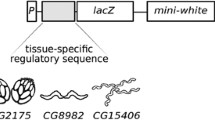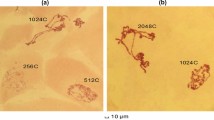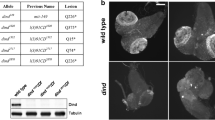Summary
The effects of chromosomal rearrangements pn2, pn3, TE100 and TE101 on variegation of the gene Pgd, which controls the synthesis of 6-phosphogluconate dehydrogenase (PGD), were studied in Drosophila melanogaster. The electrophoretic patterns of PGD activity were first examined at different developmental stages. The degree of variegation of Pgd caused by pn2 and pn3 was higher in adult flies (the calculated percentage of cells with inactive Pgd was 70%–80%) as compared with larvae (about 50%). This difference can be explained by the tissue-specific mosaicism of Pgd expression; variegation was high in the neural ganglia, imaginal discs, and posterior gut but relatively low in the salivary glands, fat bodies and Malpighian tubes. In the case of TE100, neither tissue specificity, nor marked differences in the degree of variegation between larvae and adults were found. None of the rearrangements examined had an effect on the expression of Pgd in the ovary cells, but repression was seen in some cells of the male gonads. The data obtained suggest that the timing of clonal initiation is influenced by the rearrangements studied. The possible mechanisms preventing changes in the expression of the Pgd gene in the nurse cells caused by these rearrangements are discussed.
Similar content being viewed by others
References
Alatortzev VE, Tolchkov EV, Slobodyanyuk SY, Gvozdev VA (1982) Cellular variegation and antigen disappearance as a result of the position effect on the Pgd locus in Drosophila melanogaster. Genetika (in Russian) 18:13–23
Fullilove SL, Jacobson AG (1978) Embryonic development—descriptive. In: Ashburner M, Wright TRF (eds) The genetics and biology of Drosophila, vol 2c. Academic Press, London New York San Francisco, pp 106–230
Gerasímova TI, Smirnova SG (1980) A study of the maternal effect of genes coding for 6-phosphogluconate dehydrogenase and glucose-6-phosphate dehydrogenase in Drosophila melanogaster. Genetika (in Russian) 16:55–65
Hadorn E, Gsell R, Schultz J (1970) Stability of position effect variegation in normal and transdetermined larval blastemas from Drosophila melanogaster. Proc Natl Acad Sci USA 65:633–637
Henikoff S (1979) Does position effect variegation in Drosophila result from somatic gene loss? In: Maniatis T, Axel R (eds) ICN-UCLA symposium on molecular and cellular biology, vol 14. Academic Press, New York, pp 123–132
Iljina OV, Sorokin AV, Belyaeva ES, Zhimulev IF (1980) New mutants. Dros Inf Serv 55:205
Illmensee K (1972) Developmental potencies of nuclei from cleavage, preblastoderm and syncytial blastoderm transplanted into unfertilized eggs of Drosophila melanogaster. Wilhelm Roux Arch Devel Biol 170:267–298
Janning W (1970) Bestimmung des Heterochromatisierungsstudiums beim white Positionseffekt mittels röntgeninduzierter mitotischer Recombination in der Augenlage von Drosophila melanogaster. Mol Gen Genet 107:128–149
Lindsley DL, Grell EH (1968) Genetic variation of Drosophila melanogaster. Carnegie Inst Wash Publ 627
Neuhoff V (1973) Micromethos in molecular biology. Springer, Berlin Heidelberg New York, pp 49–56
Schultz J (1965) Gene, differentiation and animal development. Brookhaven Symp Biol 18:116–147
Slobodyanyuk SY, Serov OL (1983) Variations in the expression of the gene Pgd due to the effect of chromosomal rearrangements in Drosophila melanogaster. Mol Gen Genet 191:372–377
Spear BB (1977) Differential replication of DNA sequences in Drosophila chromosomes. Am Zool 17:695–706
Spofford JB (1976) Position-effect variegation in Drosophila. In: Ashburner M, Novitski E (eds) The genetics and biology of Drosophila, vol 1c. Academic Press, London New York San Francisco, pp 955–1018
Tobler JE, John YJ, Grell EH, Bruce JK (1979) Developmental changes of sepiapterin synthase activity associated with a variegated purple gene in Drosophila melanogaster. Biochem Genet 17:197–206
Author information
Authors and Affiliations
Additional information
Communicated by H. Böhme
Rights and permissions
About this article
Cite this article
Slobodyanyuk, S.Y., Serov, O.L. Stage and organ specificity of the degree of variegation of the 6-phosphogluconate dehydrogenase gene in Drosophila melanogaster . Mole Gen Genet 208, 329–334 (1987). https://doi.org/10.1007/BF00330461
Received:
Issue Date:
DOI: https://doi.org/10.1007/BF00330461




